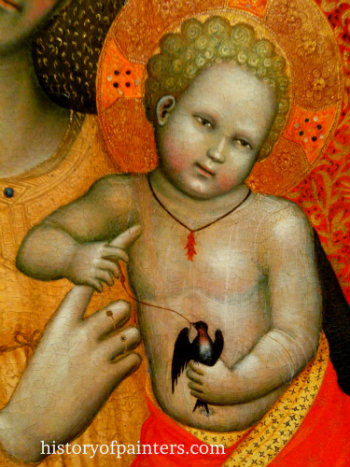|
|
|
|
You are here history of painters > Art Movements > Renaissance > The Renaissance During the Renaissance
the Artist was
elevated in social standing and his art was looked upon not as simple
crafts, but as divinely inspired creations. The spirit of an era awoke,
revitalized with knowledge and creativity. Paintings of the time period
are intensely passionate with dramatic use of light. Florence was the
epicenter of the Renaissance movement. Historian Jacob Burckhardt
describes the city thusly, "Florence, the great market of fame, was in
this point, as we have said, in advance of other cities. 'Sharp
eyes and bad tongues' is the description given of the inhabitants. An
easygoing contempt of everything and everybody was probably the
prevailing tone of society."
The techniques used by painters of the High Renaissance were
quite innovative in themselves. Their use of incandescent colors
created with newly developed oil mediums gave a unique vividness to
their paintings.
Michelangelo
and
Leonardo Da Vinci
would not hesitate to directly sketch a reeking, decomposing
human cadaver for the purpose of painting the human body realistically.
Distinguished author and historian, John C. Van Dyke points out "What
they sought, primarily, was the light and shade on a nude shoulder, the
delicate contours of a form, the flow and fall of silk or brocade, the
richness of a robe, a scheme of color or of light, the character of a
face, the majesty of a figure. They were seeking effects of line,
light, color—mere sensuous and pictorial effects, in which religion and
classicism played secondary parts. They believed in art for art's sake;
that painting was a creation, not an illustration; that it should exist
by its pictorial beauties, not by its subject or story. No matter what
their subjects, they invariably painted them so as to show the beauties
they prized the highest. The Venetian conception was less[111] austere,
grand, intellectual, than pictorial, sensuous, concerning the beautiful
as it appealed to the eye. And this was not a slight or unworthy
conception. True it dealt with the fullness of material life, but
regarded as it was by the Venetians—a thing full-rounded, complete,
harmonious, splendid—it became a great ideal of existence."
Until the Middle Ages men regarded themselves as following the Good Shepherd, and art consequently did not recognize the individual in particular. In the structure and position of the figures, as in their expression, a general and uniform type of beauty prevailed. The early Renaissance marks the victory of individualism and the uncompromising prominence of he individual. An abundance of sharply outlined characters suddenly appears, robust, clear-cut personalities; lawless nature belonging just as much in the gallery of criminals as in that of great men. Character, individuality, power and energy are the passwords of the Renaissance age. This new humanity, all these rugged and manly figures which the age had created, had also to appear in painting. In contrast to the former preference for beauty of an angelic and tender type, the problem now was to depict energetic and powerful beings; and to replace shy and feminine, though bearded, men in the pictures of the older masters by angular, harsh determined and daring types. The figures which has formerly hovered like spirits above the earth had now to stand firmly upon their own feet and become part of their earthly home. -- Richard Muther, The History of Painting, Henry and Co., London, 1896 The Greatest Artists of the Italian Renaissance
|
|
|
|
|
|
Key Descriptive Words and Phrases associated with The Renaissance Era - rebirth, rediscovery of the classical world, publication of Della Pittura, a book about the laws of mathematical perspective for artists, spiritually significant, Age of Discovery, curiosity about the natural world, idealized biblical themes, realistic use of colours and light, Old Testament stories, pre-Constantinian period, ethereal and foggy backgrounds , Gospel parables, romanticized landscapes, Christian symbolism. Require more facts and information about The High Renaissance? Poke around every nook and cranny of the known universe for information this subject. Search Here © HistoryofPainters.com If you like this page and wish to share it, you are welcome to link to it, with our thanks. If you feel you have worthwhile information you would like to contribute we would love to hear from you. We collect essential biographical information and artist quotes from folks all over the globe and appreciate your participation. When submitting please, if possible, site the source and provide English translation. Email to millardmulch@gmail.com |
